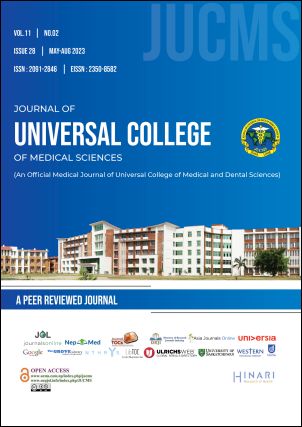Functional Outcomes of Close Reduction and Percutaneous Pinning in Proximal Humerus Fractures
DOI:
https://doi.org/10.3126/jucms.v11i02.57893Keywords:
Proximal humerus fracture, CLosed reduction and percutaneous pinning, Functional outcomeAbstract
INTRODUCTION Proximal humerus fractures are usually sustained from trivial fall in elderly. These fractures are usually associated with severe degree of comminution and deformity. Therefore, anatomical reduction of fracture fragments, and early mobilization are key factors for optimal outcomes of involved limb. This study was intended to evaluate the functional outcomes of proximal humer- us fractures in adults managed by closed reduction and percutaneous pinning (CRPP).
MATERIAL AND METHODS This prospective and observational hospital based study was carried out in Orthopedics Department, Universal College of medical Sciences-Teaching Hospital (UCMS-TH) from July 2021 to June 2023. All patients with proximal humerus fractures who fulfilled the inclusion criteria and who underwent closed reduction and percutaneous pinning were enrolled in the study and functional outcome was assessed according to Constant murley scoring system and Visual analogue score. Post-operatively patients were regularly followed at 6 weeks, 3 months and 6 months.
RESULTS In this study of 60 cases, the mean age group was 53.08±13.10 years and male patients outnumbered female patients (37 males and 23 females). Forty one cases (68.3%) were of right side and 19 (31.7%) were of the left side. Majority of the fractures were due to fall injury (53.3%), followed by road traffic accident (40%). The mean Constant Murley Score was 76.95 ± 5.53 and VAS (visual analogue score) was 1.97 ± 0.97.
CONCLUSION Closed reduction and percutaneous pinning is simple, less invasive and effective procedure for proximal humerus fracture providing good functional outcome.
Downloads
Downloads
Published
How to Cite
Issue
Section
License
Copyright (c) 2023 Journal of Universal College of Medical Sciences

This work is licensed under a Creative Commons Attribution-NonCommercial 4.0 International License.
Authors have to give the following undertakings along with their article:
- I/we declare that this article is original and has not been submitted to another journal for publication.
- I/we declare that I/we surrender all the rights to the editor of the journal and if published will be the property of the journal and we will not publish it anywhere else, in full or part, without the permission of the Chief Editor.
- Institutional ethical and research committee clearance certificate from the institution where work/research was done, is required to be submitted.
- Articles in the Journal are Open Access articles published under the Creative Commons CC BY-NC License (https://creativecommons.org/licenses/by-nc/4.0/)
- This license permits use, distribution and reproduction in any medium, provided the original work is properly cited, and it is not used for commercial purposes.




